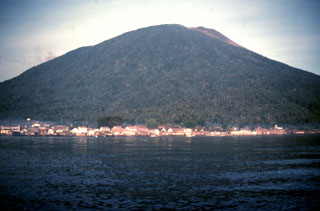Report on Gamalama (Indonesia) — 21 February-27 February 2024
Smithsonian Institution / US Geological Survey
Weekly Volcanic Activity Report, 21 February-27 February 2024
Managing Editor: Sally Sennert.
Please cite this report as:
Global Volcanism Program, 2024. Report on Gamalama (Indonesia) (Sennert, S, ed.). Weekly Volcanic Activity Report, 21 February-27 February 2024. Smithsonian Institution and US Geological Survey.
Gamalama
Indonesia
0.81°N, 127.3322°E; summit elev. 1714 m
All times are local (unless otherwise noted)
Although there was no eruptive activity reported at Gamalama, in a 23 February press release PVMBG noted that the number of daily deep volcanic earthquakes had significantly increased. A total of 14 deep volcanic earthquakes were recorded by the seismic network on 22 February, higher than the average of 2-3 events per day that had been recorded since January 2023. At 1623 on 22 February an observer saw a dense white-to-gray ash plume rising 400 m above the summit and drifting W. During 0000-0830 on 23 February the network recorded an additional four deep volcanic earthquakes as well as three events indicating emissions; dense white plumes were visible rising 100-400 m above the summit and drifting N. Seismicity before the increase, during 1-22 February, consisted of one tornillo earthquake, two harmonic earthquakes, one shallow volcanic earthquake, 34 deep volcanic earthquakes, two seismic events indicating floods or lahars, and 26 events indicating emissions. The Alert Level remained at 2 (on a scale of 1-4); visitors and residents were warned not to approach the crater within a 1.5-km radius.
Geological Summary. Gamalama is a near-conical stratovolcano that comprises the entire island of Ternate off the western coast of Halmahera, and is one of Indonesia's most active volcanoes. The island was a major regional center in the Portuguese and Dutch spice trade for several centuries, which contributed to the extensive documentation of activity. Three cones, progressively younger to the north, form the summit. Several maars and vents define a rift zone, parallel to the Halmahera island arc, that cuts the volcano; the S-flank Ngade maar formed after about 14,500–13,000 cal. BP (Faral et al., 2022). Eruptions, recorded frequently since the 16th century, typically originated from the summit craters, although flank eruptions have occurred in 1763, 1770, 1775, and 1962-63.
Source: Pusat Vulkanologi dan Mitigasi Bencana Geologi (PVMBG, also known as CVGHM)

